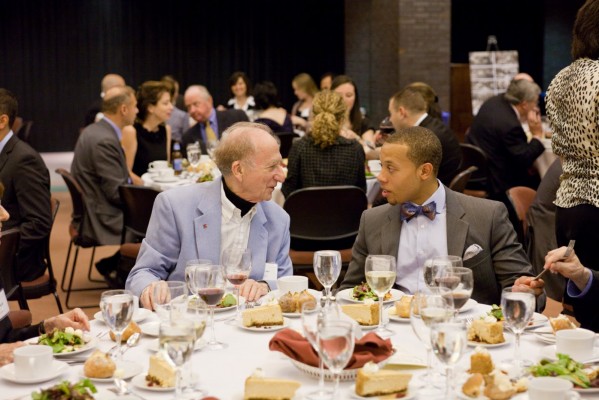
The Board of Student Advisers has had a major impact on the first-year education of Harvard Law students for over 100 years. Yet despite counting luminaries like Supreme Court Justice Anthony Kennedy among its ranks, the history and purpose of the Board remains a mystery to most students, whose only contact with the Board comes in their First-Year Legal Research and Writing (“LRW”) program and perhaps through the yearly Ames Competition.
The role of the Board at the Law School has been continuously re-examined, especially with implementation of the modern form of the LRW Program in 2002. The truth is that the Board walks a fine line, attempting to serve as instructors and friends to incoming 1Ls while staying relevant and involved in LRW.
A Storied History
For almost 150 years, HLS students organized themselves into “law clubs.” These small and elitist groups (such as the Marshall Club, the Kent Club and the Pow-Wow Club) were formed to discuss and argue cases, as well as to provide a social atmosphere for their members. Many clubs established their own moot courts, which ran in parallel to the faculty-run HLS moot court.
By the turn of the twentieth century, enrollment at HLS had dramatically increased. This led to the cancellation of the faculty-run moot court, which had become too burdensome to administer. Law clubs were left as the only places where HLS students could receive training in court practice.
A number of new clubs were formed during the early part of the century, but these clubs still counted only a small minority of students among their members. In response, concerned faculty passed a resolution in 1910 that established the Board of Student Advisers “for encouraging among first year students early and intelligent use of the law library and also for rendering the work of the law clubs more efficient.”
The Board was originally an honorary society, with membership chosen by the faculty. Board members focused mainly on the Ames Competition: writing the cases to be argued, teaching legal research, and organizing independent law clubs so that all first-year students could participate.
Although its student-centered teaching methods were lauded, the Board ran into its share of difficulties, especially as it had trouble finding faculty who were willing to take responsibility for training its teachers. In addition, participation in the Ames Competition steadily declined over the years. By 1970, most of the law clubs had disappeared, and the Board was in need of a new role.
The Board’s first response was to begin offering courses (including Gambling, Bartending and Bicycle-Care), organizing social activities, and leading orientation. That, however, led many to conclude that the Board had drifted away from its dedication to legal research and education, which in turn prompted the faculty to redefine the organization’s role in 1993. The faculty agreed to directly oversee selection of BSA applicants, who then were enlisted to teach the 1L Introduction to Lawyering course. This course was later renamed Legal Reasoning and Argument (“LRA”), the precursor to today’s LRW.
The Move to LRW
The LRA program had several flaws. In the fall of 1998, an LRA Committee was formed to explore ways to reform the program. These proposals would eventually lead to the LRW program in place today.
The biggest difference between LRA and LRW is that LRA was staffed entirely by student BSA instructors, without the leadership of a Climenko Fellow. The LRA Committee made this change because it felt that it was not appropriate for the entirety of legal research and writing to be taught by student instructors with only a year’s worth of experience in the law. The Board initially resisted the proposed changes: BSAs were used to a system where they worked without oversight from full-time teachers and had developed their own culture and approach. Many BSAs felt that the faculty had not sufficiently consulted with them before making such sweeping changes.
It took the Board several years to adjust to its new role and relationship with faculty and students, but in the past five years, the organization has stopped looking to the past and has started to re-build itself as a central part of the HLS experience. This year (2018–19), the BSA has 42 student members, selected based on grades, editing and feedback skills, and an essay. A committee of current BSA members selects new BSAs with review by Susannah Barton Tobin, the head of the LRW program, and with faculty and Climenko Fellow input. Three BSAs are assigned to support each section of LRW, which is taught primarily by a Climenko Fellow. Climenko Fellows are promising legal scholars with high academic achievements and a strong interest in teaching, who spend two years teaching LRW and preparing scholarship for entry into the teaching market.
Specific BSA responsibilities vary from section to section, but each BSA is broadly responsible for serving as teaching assistants to his or her Climenko Fellow, serving as academic advisers and general mentors to a group of 10-15 1Ls, and assisting with the First-Year and Upper Level Ames Moot Court Competitions.
(This is an edited and adapted version of the article by Jon Lamberson, originally published in the HLS Record, November 21, 2002. Much of the background material for this piece may be found in the third-year paper by Katherine M. Porter HLS ’01 entitled “Learning by Doing: A History of the Board of Student Advisers 1910–2000,” available in the BSA Office.)
